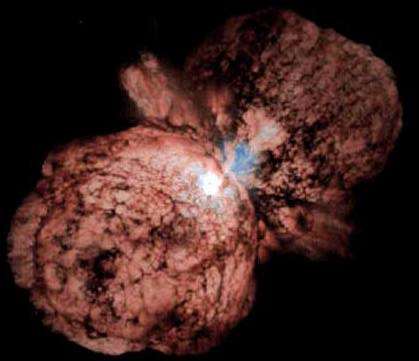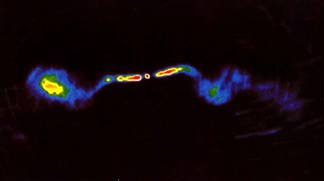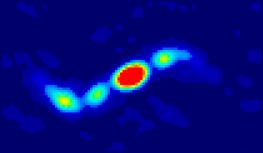Most of the energy of the wave will rebound and sweep towards the other pole. (If you analyze the fields, you will find the natural thing for the fields to do at the poles is to change direction and go in the opposite direction.) However, depending on how fast the field (wave) approaches the pole, some of the energy of the core ball-of-light will be lost in the form of photons and ejected balls-of-light. At lower energies, only photons are induced. At some point, if the energy of the wave is high enough, the energy curls around itself and may form an elementary particle.
The ejected particle's "lifetime" will depend on its harmonics. If it is a harmonic particle, then it will survive. If it is a nonharmonic particle, then it will decay. In general, the less harmonic the particle is, then the faster it will decay. A nonharmonic particle may even explode as soon as it is created.
In general, the faster the particle is ejected, the longer it will survive due to higher induced electric, magnetic and gravitational fields. It is almost as if the faster the particle is ejected, the "harder" it is.
What happens with the electric and magnetic fields of the two particles immediately after the smaller particle is induced? The electric and magnetic fields of the two balls-of-light would be almost exactly adjacent to each other and would create a massive repulsing force at this stage. Thus, the smaller of the two objects would be ejected with high velocity.
Graphic of the fields opposing each other
If an object impacts a star like our sun, what would happen? I've created an animated GIF of this happening:
(QuickTime Animation of this graphic -- 97K)
In the first few frames of this animation, an object -- such as an asteroid or comet -- is moving towards the star from the left. The star's core is a ball-of-light. Its outer envelope of material has been primarily made by induction from the core. The rest of the material has been gravitationally accreted. As the object impacts the outer plasma envelope: a splash of material is ejected to the left, and a massive wave sweeps around the outer envelope to the right. This massive wave is made of ionized plasma. (It is assumed for this example that the impacting object is not big enough nor has enough energy to penetrate the outer envelope and hit the core. The Ball-of-Light Particle Model predicts this is one cause of Supernovas.) The moving electromagnetic field in the wave induces waves on the core of the star. One such wave is represented by a vertical black line that moves across the core -- initially from left to right. As the outer wave reaches the right pole, material from the outer envelope could splash off the pole, but the majority of the wave's energy would rebound and travel back to the left. As the wave on the stellar core reaches its right pole, balls-of-light are ejected. Some of them may explosively decay within the outer plasma envelope creating a solar mass ejection. Some of them may be ejected with enough force from the core to pass through the outer plasma envelope and pop out of the surface of the star -- as is depicted in the middle frames of this animation. Some of the ejected balls-of-light decay explosively and are depicted here as small black crosses. Ejected plasma is depicted by dots of gray. The largest ejected ball-of-light is depicted as gray because it is "fizzling" as it decays -- essentially creating a very thin outer plasma layer similar to a white dwarf star. Not only does the wave in the plasma of the star rebound, the wave on the core rebounds and travels back to the left. As it reaches the left pole of the star the wave ejects more balls-of-light.
The SOHO satellite has imaged numerous comas hitting the sun creating just such explosions. One of these QuickTime animations (621K) -- from 6/1-2/98 -- can be see here.
A key question is: Does the wave on the core, weaken or strengthen? It is possible it could do either depending on the energy of the original impact and the initial stability of the star's core. If it strengthens, the star could create a planetary nebula or periodic novas. If it weakens, the star will return to normal. If the impacting object has enough energy, then the star would explode in a supernova.
After the remaining energy of the wave changes direction and sweeps towards the opposite pole, it can induce another ball-of-light that is ejected in the opposite direction. However, because energy is lost at each pole, in general, such a wave would gradually die down. This process would make most nonharmonic particles naturally seek a level that is "more harmonic".
Graphic?
The process would continue until the energy in the wave is dissipated and the core ball-of-light becomes stable. Observationally, the net effect would create a series of ejected "blobs" of material being ejected from the poles of balls-of-light. The Ball-of-Light Particle Model predicts that the size of each successive object would, normally, become smaller as the core becomes more stable.
See also Ejected "blobs" of material in space.
One of the most vivid examples of this happening is the exploding star Eta Carinae.

For a complete description of this exploding star, see Eta Carinae.
Another vivid example of a ball-of-light ejecting material from its poles is the Radio Galaxy 3C 449.

For a complete description of this exploding star, see Radio Galaxy 3C 449.
Another vivid example of a ball-of-light ejecting material from its poles is the Radio Galaxy 3C 452.

For a complete description of this exploding star, see Radio Galaxy 3C 452.
Another vivid example of a ball-of-light ejecting material from its poles is the Radio Source GRS 1915 + 105.
graphic
During a two week period from October to November 1997, the MERLIN radio telescope array in England monitored a decaying ball-of-light that ejected material from its poles at close to the speed of light. Scientists have called the objects "blobs." They are simply massive balls-of-light that are undergoing a "fizzle" type decay. The Ball-of-Light Particle Model predicts that when these balls-of-light slow down sufficiently, they may decay explosively.
The central object has been called a black hole, and a micro-quasar. It is a stellar version of a bipolar radio galaxy just like Radio Galaxy 3C 452 above.
For a complete description of this exploding star, see GRS 1915 + 105.
Another vivid example of a ball-of-light ejecting material from its poles is the Radio Source SS433.

I believe this image was taken with the MERLIN radio telescope array in England. It has been estimated that the "blobs" seen in this image are moving away from the core at about 0.26 times the speed of light. They are simply massive balls-of-light that are undergoing a "fizzle" type decay. The Ball-of-Light Particle Model predicts that when these balls-of-light slow down sufficiently, they may decay explosively.
The ejected balls-of-light are probably spinning as they move away from the central core. As they rotate and "fizzle," the secondary decay products rotate causing the spectral lines to "move" about in a 162.5 day period. Alternatively, the central core could be "precessing" like a wobbling top as it ejects balls-of-light. This could create a cone of material that might cause the doppler shifting in the ejected decay products.
(For a better description of this exploding star, see also SS433 which includes a small QuickTime Animation of SS433 62K.)